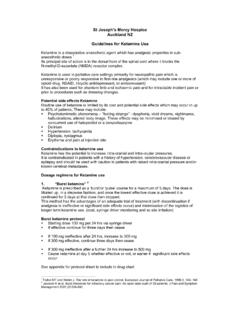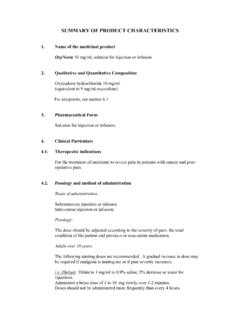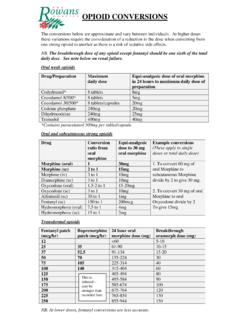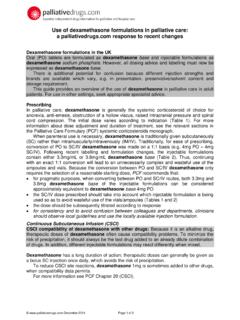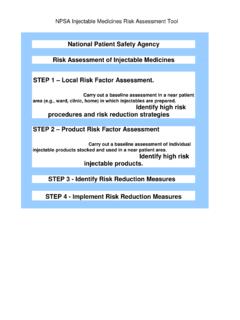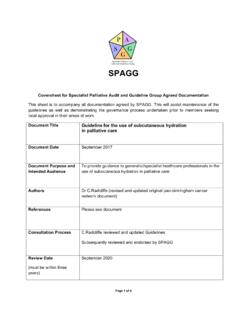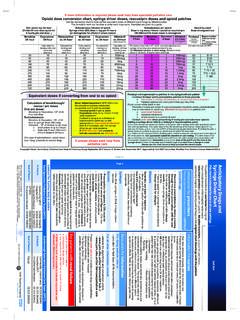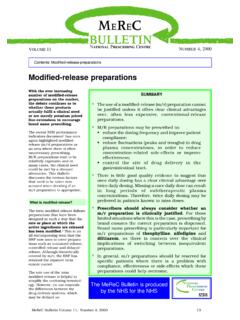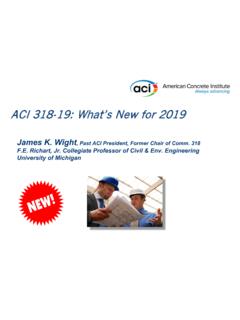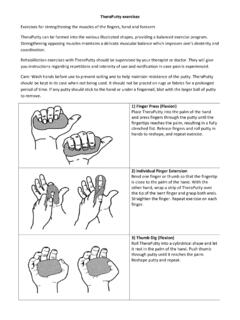Transcription of Isle of Wight Syringe Driver Compatibility Guidelines
1 Authors: Paul Howard, Graham Grove, Odran Farrell, (Version 1, March 2015; revision due March 2018) Isle of Wight Syringe Driver Compatibility Guidelines Produced by The Earl Mountbatten Hospice, Isle of Wight Written January 2015, revision due January 2018 This guideline is available as a paper pocketbook and a hyperlinked PDF: Paper pocketbook (available to all IoW clinical staff) ask your palliative care CNS Hyperlinked PDF - download from the intranet or from Authors: Paul Howard, Graham Grove, Odran Farrell, (Version 1, March 2015; revision due March 2018) Contents Morphine combinations Oxycodone combinations Fentanyl combinations Alfentanil combinations Methadone combinations Opioid-free combinations Dexamethasone combinations for site reactions Who is this booklet for? This is intended to guide primary and secondary care clinicians throughout the Isle of Wight in deciding which medicines can be combined for use with subcutaneous Syringe drivers.
2 Roles and responsibilities Adherence to St Mary s Medicines Policy, and to GMC, NMC and GPhC professional standards, are assumed: users of this booklet need to use their clinical judgement, and if in doubt, seek advice from other sources. Layout The 3rd column indicates the diluent W = water for injections S = sodium chloride The 4th column indicates the reference source (generally gives more information about the doses combined) P. Syringe Driver compatibilities database D. Dickman A. and Schneider J. The Syringe Driver (3rd edition) copy in the pharmacy team office M. Palliative Care Matters database T. Trissel Other abbreviations used: CSCI = continuous subcutaneous infusion (synonym: Syringe Driver ) When should medicines be combined? Combining medicines in a Syringe before administration creates an unlicensed product. However, such practice is consistent with professional standards because relevant licensed combinations do not exist and administering each medicine in a separate pump is unsatisfactory (requiring a patient to have multiple SC needles and, if ambulant, carry multiple pumps).
3 Indications of incompatibility Cloudiness or visible crystals/ grit reliably indicate incompatibility (see action needed below). However, a clear solution doesn t exclude incompatibility. Other features of incompatibility include: Site reactions: usually indicates a reaction to a single constituent drug, but can be a feature of incompatibility. Unexpected worsening of symptoms: for example, where a drug is added for a 2nd symptom and the 1st (previously well controlled) symptom unexpectedly recurs. If in doubt, seek advice from a palliative care pharmacist or consultant. Combinations requiring additional caution [indicated by square brackets] Some combinations require additional care because: Similar combinations are known to be problematic, or They are based on extrapolation ( combination was previously reported with an additional drug present). When using a combination in squared brackets, look frequently for cloudiness and be alert to symptoms worsening.
4 Action if incompatibility occurs Stop the infusion. Either switch drugs or split the combination into 2 separate pumps (for example, taking the most recently added drug out and into a separate pump if the previous mix was known to be effective) Please report the problematic combination to so that it can be uploaded to the Syringe Driver Compatibility database. Please state the drugs used, the diluent, the total Syringe volume and the reason a problem was suspected ( went cloudy ) Authors: Paul Howard, Graham Grove, Odran Farrell, (Version 1, March 2015; revision due March 2018) Morphine combinations Morphine sulphate plus: Cyclizine W P Cyclizine and midazolam W P Haloperidol W/S P Haloperidol and cyclizine W P Haloperidol and cyclizine and octreotide W D Haloperidol and cyclizine and ranitidine W P Haloperidol and hyoscine butylbromide W/S P Haloperidol and hyoscine butylbromide and rantidine W P Haloperidol and hyoscine HYDRO bromide S D Haloperidol and ketamine S P Haloperidol and midazolam W/S P Haloperidol and midazolam and cyclizine W D Haloperidol and midazolam and hyoscine butylbromide W P Haloperidol and octreotide W/S P Hyoscine butylbromide W P Hyoscine butylbromide and octreotide S D Hyoscine butylbromide and ondansetron S D Hyoscine HYDRO bromide W P [Ketamine]a S P Levomepromazine W/S P Levomepromazine and hyoscine butylbromide W/S P Levomepromazine and hyoscine butylbromide and octreotide S D [Levomepromazine and hyoscine butylbromide and ranitidine]
5 B W P Levomepromazine and hyoscine HYDRO bromide S P Levomepromazine and metoclopramide W/S P/D Levomepromazine and midazolam W/S P Levomepromazine and midazolam and hyoscine butylbromide W P Levomepromazine and midazolam and hyoscine HYDRO bromide S D Levomepromazine and midazolam and metoclopramide W/S P/D Levomepromazine and midazolam and ondansetron W P Levomepromazine and octreotide W/S P Levomepromazine and ranitidine W P Metoclopramide W/S P Metoclopramide and midazolam and ketamine S D Metoclopramide and ondansetron S D Metoclopramide and ranitidine S P Midazolam W/S P Midazolam and cyclizine W P Midazolam and hyoscine butylbromide W/S P Midazolam and hyoscine butylbromide and octreotide S D Midazolam and hyoscine HYDRO bromide W/S P/D Midazolam and ketamine W/S P Midazolam and metoclopramide W/S P Midazolam and metoclopramide and octreotide W/S P/D Midazolam and octreotide W/S P Midazolam and ondansetron S P Octreotide S P Ondansetron W/S D Ondansetron and metoclopramide and octreotide S D Ranitidine W T a.
6 This combination is compatible with several other 3 and 4 drug combinations, but caution is advised because separate use of these 2 drugs has not been reported b. Use caution based on reported experience with a 5th drug Authors: Paul Howard, Graham Grove, Odran Farrell, (Version 1, March 2015; revision due March 2018) Oxycodone combinations Oxycodone plus: [Cyclizine (avoid if oxycodone dose >100mg may precipitate)] W P Haloperidol W/S P [Haloperidol and cyclizine (avoid if oxycodone dose > 100mg may precipitate)] W P Haloperidol and hyoscine butylbromide W/S P Haloperidol and hyoscine HYDRO bromide W/S D Haloperidol and ketamine S P Haloperidol and midazolam W/S P [Haloperidol and midazolam and cyclizine (avoid if oxycodone dose > 100mg may precipitate)] W P Haloperidol and midazolam and hyoscine butylbromide W/S P Haloperidol and midazolam and ketamine S P Haloperidol and octreotide W/S P Hyoscine butylbromide W/S P Ketamine W/S P Ketorolac S D Ketorolac and ranitidine W/S D Levomepromazine W/S P Levomepromazine and hyoscine butylbromide W/S P Levomepromazine and hyoscine butylbromide and octreotide W/S P Levomepromazine and hyoscine HYDRO bromide W/S D Levomepromazine and ketamine S P Levomepromazine and metoclopramide W/S P Levomepromazine and midazolam W/S P Levomepromazine and midazolam and hyoscine butylbromide W/S P Levomepromazine and midazolam and hyoscine HYDRO bromide W/S P Levomepromazine and midazolam and octreotide W/S P Levomepromazine and midazolam and ondansetron S D Levomepromazine and octreotide W/S P Levomepromazine and octreotide and hyoscine HYDRO bromide W/S D Levomepromazine and octreotide and ondansetron W/S D Levomepromazine and ondansetron S P
7 Metoclopramide W/S P Metoclopramide and ondansetron W/S P/D Midazolam W/S P [Midazolam and cyclizine (avoid if oxycodone dose >100mg may precipitate)] W P Midazolam and hyoscine butylbromide W/S P Midazolam and ketamine W/S P Midazolam and metoclopramide W/S P Midazolam and octreotide W/S P/D Midazolam and ondansetron W/S P/D Octreotide W/S P Octreotide and ondansetron W/S P/D Ondansetron W/S P Ranitidine W/S D Authors: Paul Howard, Graham Grove, Odran Farrell, (Version 1, March 2015; revision due March 2018) Fentanyl combinations Fentanyl plus: Haloperidol W P Haloperidol and midazolam W P Haloperidol and midazolam and hyoscine butylbromide W P Hyoscine butylbromide W P Levomepromazine W P Levomepromazine and metoclopramide W P Levomepromazine and midazolam W P Levomepromazine and midazolam and metoclopramide W P Levomepromazine and ranitidine S M Metoclopramide W P Midazolam W P Midazolam and cyclizine W D Midazolam and hyoscine butylbromide S D Midazolam and metoclopramide S D Ondansetron S D Ranitidine S T Alfentanil combinations Fentanyl is the preferred opioid for renal impairment.
8 Alfentanil CSCI is used if higher opioid doses cause volume problems with fentanyl, oxycodone or morphine sulphate Alfentanil plus: Haloperidol W/S P [Haloperidol and cyclizine]c W P Haloperidol and cyclizine and octreotide W D Haloperidol and hyoscine butylbromide W P Haloperidol and midazolam W/S P [Haloperidol and midazolam and cyclizine] W D Haloperidol and midazolam and hyoscine butylbromide W/S D Haloperidol and ondansetron S D Hyoscine butylbromide S D Levomepromazine W/S P/D Levomepromazine and hyoscine butylbromide S P Levomepromazine and hyoscine butylbromide and octreotide S D Levomepromazine and hyoscine butylbromide and ondansetron S D Levomepromazine and metoclopramide W/S P/D Levomepromazine and midazolam W/S P Levomepromazine and midazolam and hyoscine butylbromide W/S D Levomepromazine and midazolam and metoclopramide S D Levomepromazine and octreotide W/S P Levomepromazine and octreotide and ondansetron S D Levomepromazine and ondansetron S D Metoclopramide W/S P Midazolam W/S P [Midazolam and cyclizine]
9 C W D Midazolam and hyoscine butylbromide W/S P Midazolam and metoclopramide W/S D Midazolam and octreotide S D Midazolam and ondansetron W/S D Octreotide W/S P/D Ondansetron W/S P/D c. Although numerous reports of this 3 drug combination, use caution because alfentanil/cyclizine alone is reported to be incompatible Authors: Paul Howard, Graham Grove, Odran Farrell, (Version 1, March 2015; revision due March 2018) Methadone combinations Methadone plus: Cyclizine W P Haloperidol W P Haloperidol and midazolam W P Haloperidol and ranitidine and hyoscine butylbromide S P Hyoscine butylbromide and ranitidine S P Ketamine W/S P Ketamine and midazolam W P Levomepromazine W P Levomepromazine and hyoscine butylbromide W P Levomepromazine and midazolam and hyoscine butylbromide S D Midazolam W P Octreotide and ranitidine S P Opioid-free combinations Haloperidol and cyclizine W P Haloperidol and hyoscine butylbromide W D Haloperidol and hyoscine butylbromide and ranitidine W/S P Haloperidol and hyoscine butylbromide and octreotide and ranitidine S P Haloperidol and ketamine S P Haloperidol and midazolam W P Haloperidol and midazolam and cyclizine W P Haloperidol and midazolam and hyoscine butylbromide S P Haloperidol and midazolam and ketamine W P Haloperidol and midazolam and metoclopramided W/S P/D Haloperidol and midazolam and octreotide S P Haloperidol and ondansetron S P Hyoscine
10 Butylbromide and ondansetron S D Ketorolac and ranitidine S D Levomepromazine and hyoscine butylbromide and octreotide W/S P Levomepromazine and ketamine S D Levomepromazine and midazolam W/S P Levomepromazine and midazolam and octreotide S D Levomepromazine and octreotide W/S P Levomepromazine and octreotide and ondansetron S D Levomepromazine and ondansetron W/S P Metoclopramide and ondansetron S P Metoclopramide and midazolam and ranitidine S P Metoclopramide and ranitidine S P [Midazolam and cyclizine]e W P Midazolam and hyoscine butylbromide S D Midazolam and ketamine S P Midazolam and metoclopramide W/S D Midazolam and ondansetron S D Octreotide and ondansetron W/S D d. If using for nausea, consider switching rather than combining haloperidol and metoclopramide: although chemically compatible, their actions overlap (and increase the risk of extrapyramidal effects). e. Use caution: occasional incompatibility reported, but mostly reported to be compatible Single drug CSCIs (cannot be combined in the same Syringe with other drugs) Diclofenac By CSCI only.
